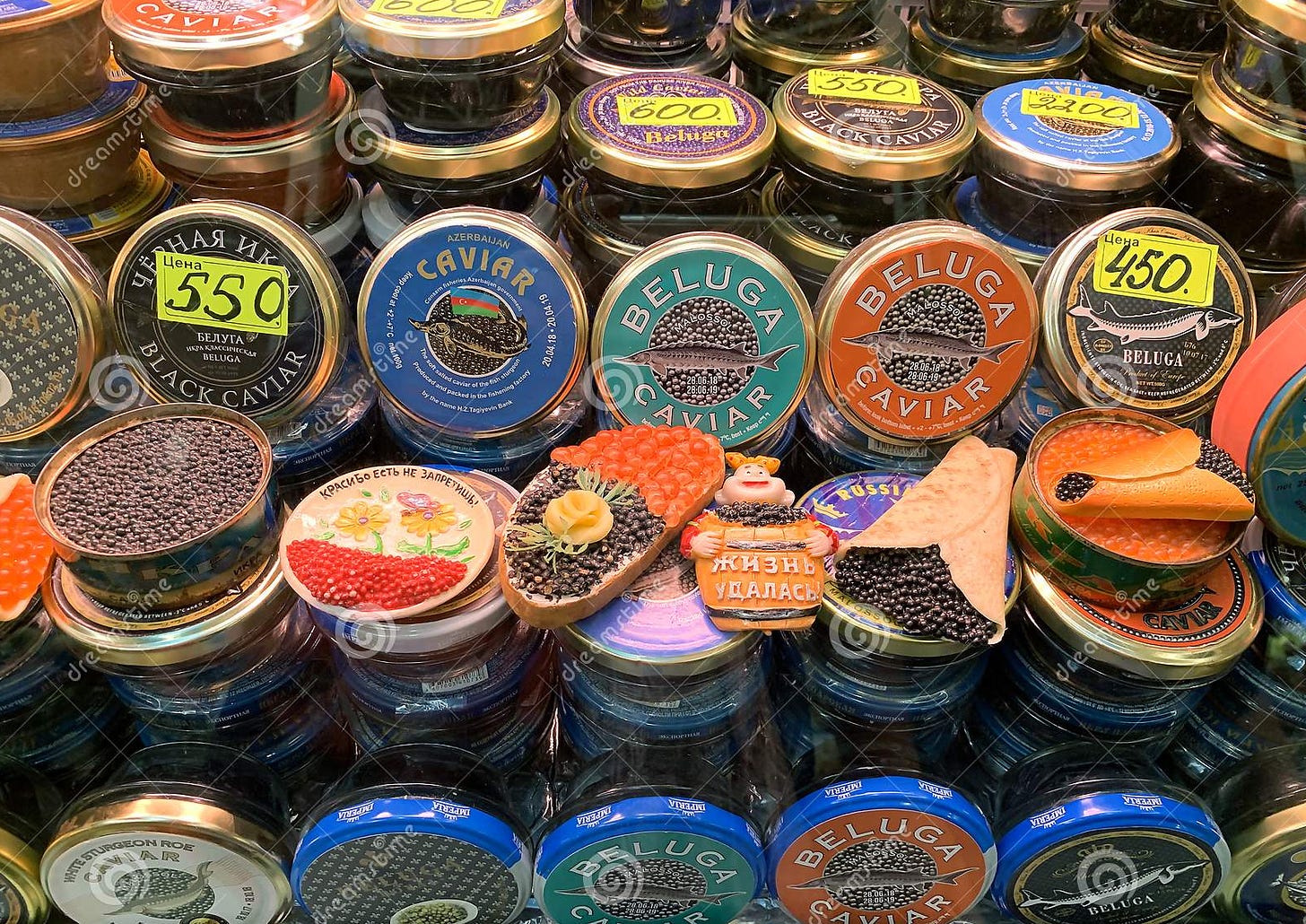Welcome to the latest installment of Notable Sandwiches, the feature where I, alongide my editor David Swanson, stumble through the demented and mysterious document that is Wikipedia’s List of Notable Sandwiches. This week: a Russian standard, the caviar sandwich.
Author’s note: to improve accessibility and offer you another way of enjoying the newsletter, I’m going to record audio tracks to accompany the content whenever possible, so you can listen as well as read! This may not feature in every post, but I’ll try to make it a regular thing.
What a time to be writing about caviar.
I generally enjoy these sandwich columns as an opportunity to get my head out of the relentless river of shit that is American politics—I get to delve into food history, imagine or recreate beautiful and strange flavors, consider bread and its accoutrements with at times unnecessary gravity. And the truth is I love caviar. But it feels like farting in an elevator, to be writing about caviar right now. Everything is fucked, fucked, fucked, and I’m writing about glamorous little fish eggs that cost obscene amounts for a spoonful. That is, if we’re talking about the real stuff—the sturgeon stuff, the kind you eat in microgranules and that explodes on your palate all sea and salt and more umami than a cave complex full of mushrooms, slit out of a pregnant fish’s belly from the Caspian Sea, the future of an endangered species shipped in jars, to perish in ecstasy on your waiting tongue.
You can get that kind of caviar half-salted, full-salt, mildly salted, and all the varieties are insanely, unfairly, stupidly delicious—and all of them seem like spectacularly futile subjects right now. I might as well be writing a buyer’s guide to gold bullion, if you could fit gold bullion on a toast point. (Incidentally, gold leaf, which can be purchased quite cheaply and instantly allows you to astronomically raise food prices for consumption-giddy idiots, goes through the body near-completely unprocessed and therefore produces gold-flecked shit, and if that’s not a metaphor for something I am even more of an idiot than I suspected.)
I tried caviar in Kyiv at the Besarabsky Rynok, the big indoor food market with produce heaped like jewels and the caviar peddlers in their rows letting you taste their wares on tiny spoons—you could go stall to stall, pretending to be a prospective buyer, and get a hit each time, like a bump of cocaine, dizzying minute black heaps against white plastic. Beside the caviar stalls, big slabs of smoked fish lay on the counters like smoked quartz, whole sables gazing beakily from beside heaped pomegranates. Kyiv’s at the center of a war now, and Russia is blockading Ukraine’s food exports. One New Year’s, when I was married, my husband and I threw a formal Russian-style dinner party, flush with the promise that our life together would last forever. We rode the train all the way out to Brighton Beach holding hands, and bought a precious jar of caviar and daubed it on halved new potatoes that we’d topped with crème fraîche, and a year and a half later we were divorced.
Fucked, fucked, fucked, no amount of gorgeous-tasting eggs scooped from the corpse of a big slow primeval fish can rescue it.
The caviar sandwich depicted on the Wikipedia list isn’t even made with the sexy caviar, that perennial metonym for riches because of its scarcity. It’s not sturgeon caviar, which hyper-connected Soviet bureaucrats used to smuggle in suitcases to the ultra-elite, the kind people probably eat on yachts to this day. The caviar depicted in the Wikipedia photo are still fish eggs—it’s the same word in Russian, ikra—but it’s salmon roe, infinitely cheaper and utterly ubiquitous in any Russian and Ukrainian household. It’s a very common treat—this particular sandwich is a variant on the butterbrot, a thin slice of dark bread smeared with butter and topped with the pink swollen pearls that could have been salmon, but aren’t, because you’re eating them unborn. They’re dressed lightly with salt, and to be honest I find them disgusting.
The Sword and the Sandwich is a newsletter about serious extremism and equally serious sandwiches. Please consider supporting this work with a paid subscription:
If you’ve had the misfortune to run up against molecular gastronomy—now thankfully being phased out of fine dining in favor of whatever twee farm-to-table trend makes people feel better about dropping a few hundo at dinner—you might have encountered the absolutely vile process called spherification, which is the practice of taking some liquid and encasing it in little plastic-like nominally edible membranes to theoretically produce some sort of trompe l’oeil effect, like an ersatz egg yolk that is actually full of lemon curd or something, or a sphere of melon soup in the shape of a grape, and it leaves you with a little shroud that feels kind of like a condom in your mouth, and is disgusting and stupid. You can just eat an egg yolk, which is already perfect.
I know about spherification because, to fulfill a requirement at Harvard, I took a class called “The Science of Cooking,” hoping to learn why eggs scramble like that, and why onions go translucent, and other alchemical secrets of everyday kitchen life. Instead we had Ferran Adrià, the actual chef of the actual flagship molecular gastronomy restaurant El Bulli, actually conduct a guest lecture. Every guest lecture was about bullshit like that, stuff I did not care about, because I was twenty. I never learned why onions go translucent, but I did spend several days trying to turn an egg inside-out with science for our final-project science fair, which was sponsored by fucking Lexus.
That was a ridiculous experience. But salmon roe is nature’s way of creating the disgusting sensation of having a tiny condom filled with salty jizzwater in your mouth without having to suffer the indignity of a Harvard education. People either never shut up about going to Harvard or never talk about it at all, and usually I am in the latter camp, because, to be honest, it’s a phenomenally nasty place to go to school—like a matryoshka doll full of ever-more exclusive clubs, and some of them are secret, and the comedy magazine literally has a closely-guarded castle, and instead of frats we had something even worse called final clubs which were famous for harboring rapists, and owned all the land around campus. I did love the classes, and I learned Russian, which was great. But overall the place is very rich and very bleak and leaves a bad taste in your mouth, like the illusion of an egg.
Anyway, salmon eggs, especially on toast, look like monkeypox, and they taste like something died in a puddle of seawater, and I loathe them. The other cheap alternative to the real-deal black-tar caviar is called baklazhannaya ikra—eggplant caviar—and it’s not caviar at all; it’s just a rather nice vegetable spread that’s very savory and has some red pepper in it and is altogether pretty inoffensive. I have absolutely nothing bad to say about eggplant caviar and heartily recommend you try it.
Real caviar is fucking delicious, and I had been tasting caviar at Besarabsky Market the morning I found out my roommate and closest friend from college killed herself. We had all graduated, but she didn’t, and when in my senior year I told a dean I was afraid she would take her own life, the college banned her from campus. It didn’t want the liability of her suicide. Which happened, a year later, once her friends had gone away. I never got to say goodbye, and I could still taste salt on my lips—it was a sunny morning, and all of this, you have to understand, came rushing back to me as I sat down to write this stupid column in this stupid wrenching terrible week and had hoped to pry something good out of the depths of my brain like a luminous black egg. A small good thing.
I wasn’t intending to be this bleak. I don’t think I realized the connection was this deep—that sunny morning, those tasting spoons, that death, the first death I’d experienced of someone close to me, someone my age, and the grief that I couldn’t save her, that I was thousands of miles away tasting caviar. I promise I did not set out to depress you. I even sat down and read pages and pages about the history of caviar, which is overall—and I don’t say this about food history very often—pretty boring, insofar as the story of wealth and oppression grows redundant after enough centuries. You can buy beluga caviar, still—the end product of sturgeon poachers killing off the last of a prehistoric species—for roughly $90 per ounce, which is more expensive than most things per ounce except diamonds, and probably some skincare products.
To be honest, it is an incredible taste, like nothing else: fatty and juicy, a million flavors in a tiny bite. You will lust after it forever. You will want the moment you tasted it back, as much as you want to return to the sunny morning before you heard the news—the time before your tongue left the spoon, thinking there would never be a time without pomegranates, without caviar. You never thought it would be as bleak as this, you thought you could make it last. Next year marks a decade since that morning. It says “Forever Young” on her grave, and they wrote the years she went to Harvard on her headstone, even though that place killed her as much as anything did. I suppose you could spend all your money on caviar if you wanted; you could stuff your fridge with all those poached exploding futures until they went rank on you. Or you could be sensible and simmer an eggplant and tell yourself it’s just as good, there’s no right answer, there’s only being alive, being here while you are, a little miracle in a fragile skin.














Notable Sandwiches #27: Caviar